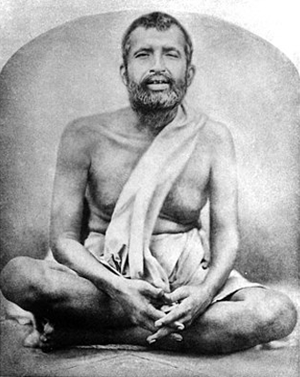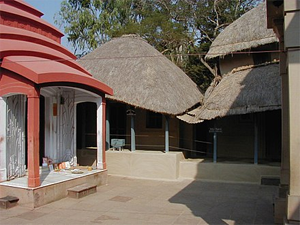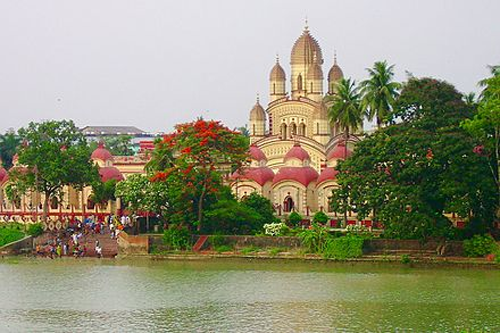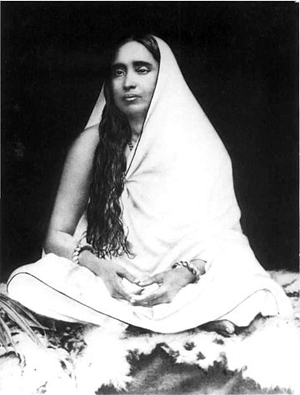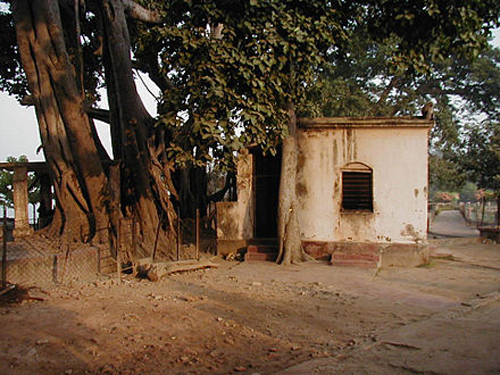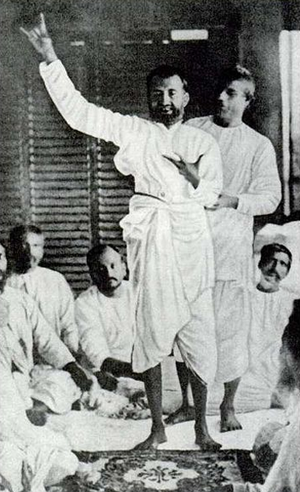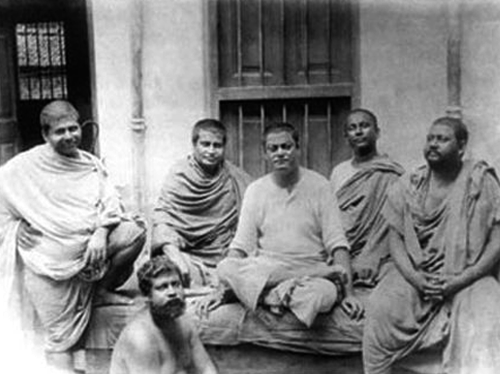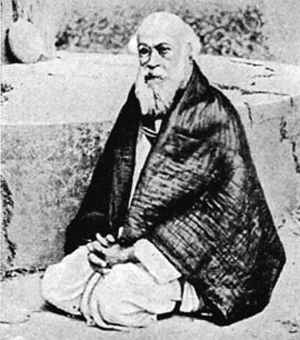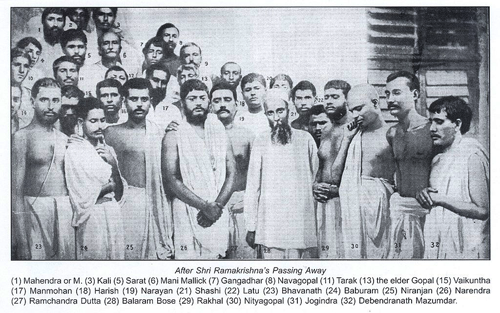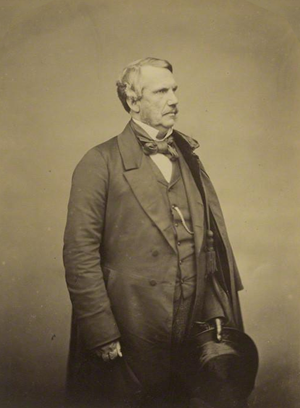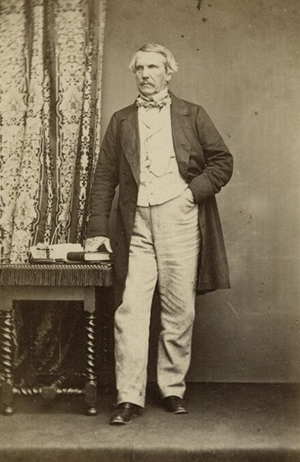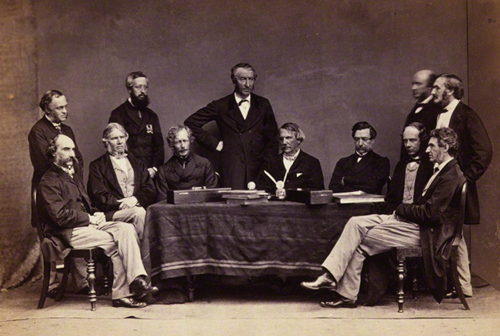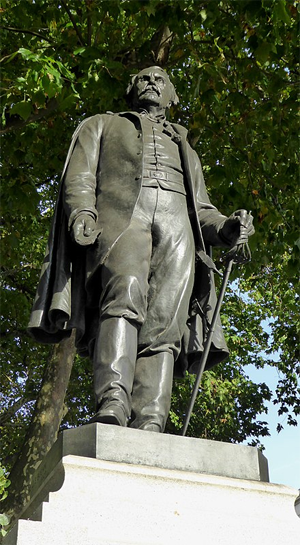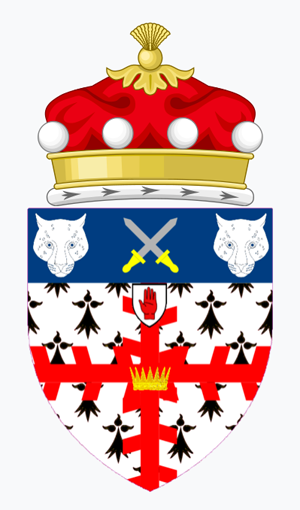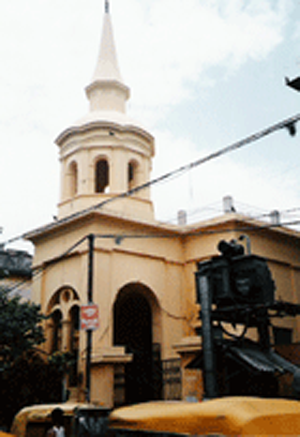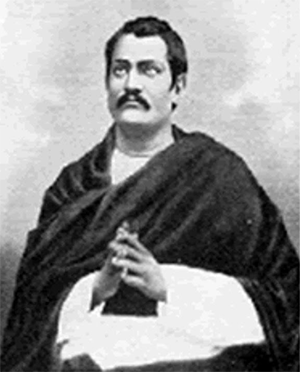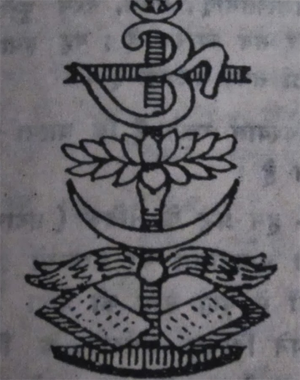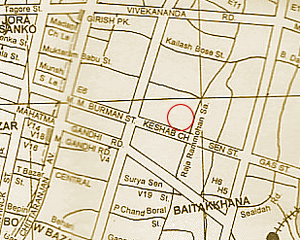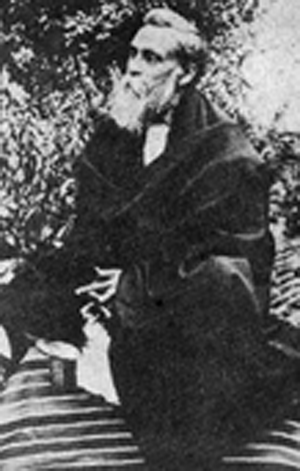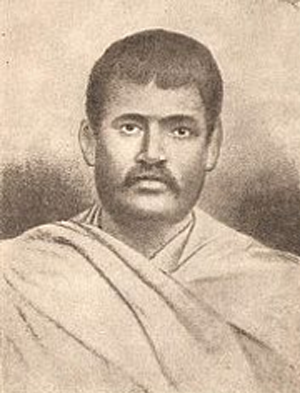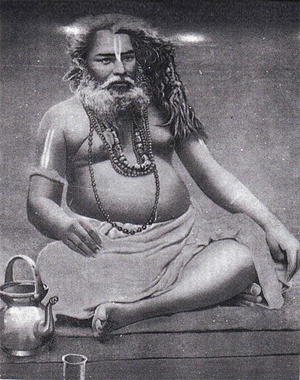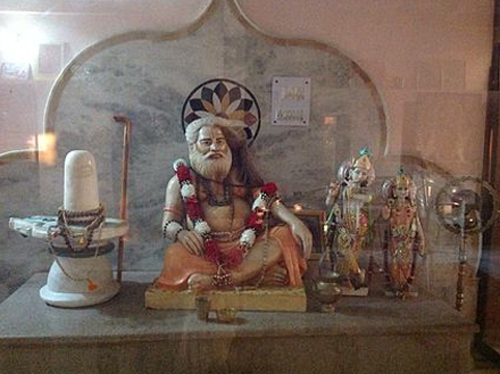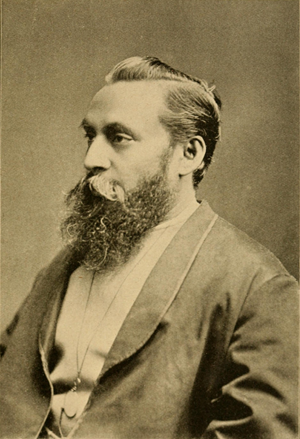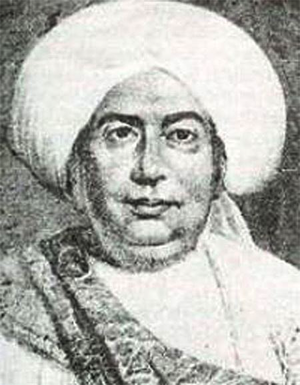Part 2 of 2
SocietyRamakrishna taught that jatra jiv tatra Shiv (wherever there is a living being, there is Shiva). His teaching, "Jive daya noy, Shiv gyane jiv seba" (not kindness to living beings, but serving the living being as Shiva Himself) is considered as the inspiration for the philanthropic work carried out by his chief disciple Vivekananda.[126]
In the Kolkata scene of the mid to late nineteenth century, Ramakrishna was opinionated on the subject of Chakri. Chakri can be described as a type of low-paying servitude done by educated men—typically government or commerce-related clerical positions. On a basic level, Ramakrishna saw this system as a corrupt form of European social organisation that forced educated men to be servants not only to their bosses at the office but also to their wives at home. What Ramakrishna saw as the primary detriment of Chakri, however, was that it forced workers into a rigid, impersonal clock-based time structure. He saw the imposition of strict adherence to each second on the watch as a roadblock to spirituality. Despite this, however, Ramakrishna demonstrated that Bhakti could be practised as an inner retreat to experience solace in the face of Western-style discipline and often discrimination in the workplace.[127]
His spiritual movement indirectly aided nationalism, as it rejected caste distinctions and religious prejudices.[116]
Reception and legacyMain articles: Ramakrishna's influence and Ramakrishna Mission
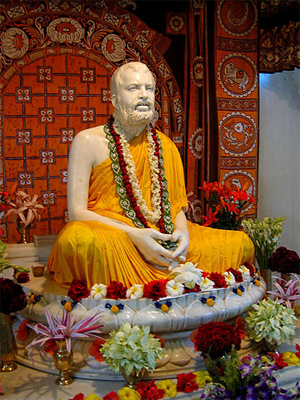 The marble statue of Ramakrishna at Belur Math, the headquarters of the Ramakrishna Mission
The marble statue of Ramakrishna at Belur Math, the headquarters of the Ramakrishna MissionRamakrishna is considered an important figure in the Bengali Renaissance of 19th–20th century. Several organisations have been established in his name.[128] The Ramakrishna Math and Mission is the main organisation founded by Swami Vivekananda in 1897. The Mission conducts extensive work in health care, disaster relief, rural management, tribal welfare, elementary and higher education. The movement is considered as one of the revitalisation movements of India. Amiya Sen writes that Vivekananda's "social service gospel" stemmed from direct inspiration from Ramakrishna and rests substantially on the "liminal quality" of the Master's message.[129]
Other organisations include the Ramakrishna Vedanta Society founded by Swami Abhedananda in 1923, the Ramakrishna Sarada Math founded by a rebel group in 1929, the Ramakrishna Vivekananda Mission formed by Swami Nityananda in 1976, and the Sri Sarada Math and Ramakrishna Sarada Mission founded in 1959 as a sister organisation by the Ramakrishna Math and Mission.[128]
Rabindranath Tagore wrote a poem on Ramakrishna, To the Ramakrishna Paramahamsa Deva:[130]
Diverse courses of worship from varied springs of fulfillment have mingled in your meditation.
The manifold revelation of the joy of the Infinite has given form to a shrine of unity in your life
where from far and near arrive salutations to which I join my own.
During the 1937 Parliament of Religions, which was held at the Ramakrishna Mission in Calcutta, Tagore acknowledged Ramakrishna as a great saint because
...the largeness of his spirit could comprehend seemingly antagonistic modes of sadhana, and because the simplicity of his soul shames for all time the pomp and pedantry of pontiffs and pundits.[131]
Max Müller,[132] Mahatma Gandhi, Jawaharlal Nehru, Sri Aurobindo, and Leo Tolstoy have acknowledged Ramakrishna's contribution to humanity. Ramakrishna's influence is also seen in the works of artists such as Franz Dvorak (1862–1927) and Philip Glass.
Views and studiesMain article: Views on Ramakrishna
Transformation into neo-VedantinMain article: Neo-Vedanta
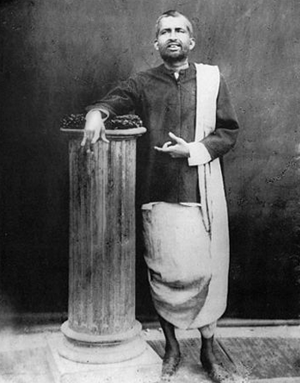 Photograph of Ramakrishna, taken on 10 December 1881 at the studio of "The Bengal Photographers" in Radhabazar, Calcutta (Kolkata).
Photograph of Ramakrishna, taken on 10 December 1881 at the studio of "The Bengal Photographers" in Radhabazar, Calcutta (Kolkata).Vivekananda portrayed Ramakrishna as an Advaita Vedantin. Vivekananda's approach can be located in the historical background of Ramakrishna and Calcutta during the mid-19th century.[133] Neevel notes that the image of Ramakrishna underwent several transformations in the writings of his prominent admirers, who changed the 'religious madman' into a calm and well-behaving proponent of Advaita Vedanta.[51] Narasingha Sil has argued that Vivekananda revised and mythologised Ramakrishna's image after Ramakrishna's death.[134] McDaniel notes that the Ramakrishna Mission is biased towards Advaita Vedanta, and downplays the importance of Shaktism in Ramakrishna's spirituality.[135] Malcolm McLean argued that the Ramakrishna Movement presents "a particular kind of explanation of Ramakrishna, that he was some kind of neo-Vedantist who taught that all religions lead to the same Godhead."[136]
Carl Olson argued that in his presentation of his master, Vivekananda had hid much of Ramakrishna's embarrassing sexual oddities from the public, because he feared that Ramakrishna would be misunderstood.[137] Tyagananda and Vrajaprana argue that Oslon makes his "astonishing claim" based on Kripal's speculations in Kali's Child, which they argue are unsupported by any of the source texts.[138]
Sumit Sarkar argued that he found in the Kathamrita traces of a binary opposition between unlearned oral wisdom and learned literate knowledge. He argues that all of our information about Ramakrishna, a rustic near-illiterate Brahmin, comes from urban bhadralok devotees, "...whose texts simultaneously illuminate and transform."[139]
Amiya Prosad Sen criticises Neevel's analysis,[140] and writes that "it is really difficult to separate the Tantrik Ramakrishna from the Vedantic", since Vedanta and Tantra "may appear to be different in some respects", but they also "share some important postulates between them".[141]
PsychoanalysisIn 1927 Romain Roland discussed with Sigmund Freud the "oceanic feeling" described by Ramakrishna.[142] Sudhir Kakar (1991),[143] Jeffrey Kripal (1995),[72] and Narasingha Sil (1998),[144] analysed Ramakrishna's mysticism and religious practices using psychoanalysis,[145] arguing that his mystical visions, refusal to comply with ritual copulation in Tantra, Madhura Bhava, and criticism of Kamini-Kanchana (women and gold) reflect homosexuality.
Romain Rolland and the "Oceanic feeling"See also: Geschwind syndrome
The dialogue on psychoanalysis and Ramakrishna began in 1927 when Sigmund Freud's friend Romain Rolland wrote to him that he should consider spiritual experiences, or "the oceanic feeling," in his psychological works.[142][146] Romain Rolland described the trances and mystical states experienced by Ramakrishna and other mystics as an "'oceanic' sentiment", one which Rolland had also experienced.[147] Rolland believed that the universal human religious emotion resembled this "oceanic sense."[148] In his 1929 book La vie de Ramakrishna, Rolland distinguished between the feelings of unity and eternity which Ramakrishna experienced in his mystical states and Ramakrishna's interpretation of those feelings as the goddess Kali.[149]
The Analyst and the MysticIn his 1991 book The Analyst and the Mystic, Indian psychoanalyst Sudhir Kakar saw in Ramakrishna's visions a spontaneous capacity for creative experiencing.[150] Kakar also argued that culturally relative concepts of eroticism and gender have contributed to the Western difficulty in comprehending Ramakrishna.[151] Kakar saw Ramakrishna's seemingly bizarre acts as part of a bhakti path to God.[152]
Kali's ChildIn 1995, Jeffrey J. Kripal in his controversial[153][154] Kali's Child: The Mystical and the Erotic in the Life and Teachings of Ramakrishna, an interdisciplinary[155] study of Ramakrishna's life "using a range of theoretical models," most notably psycho-analysis,[115] argued that Ramakrishna's mystical experiences could be seen as symptoms of repressed homoeroticism,[155] "legitimat[ing] Ramakrishna's religious visions by situating psychoanalytic discourse in a wider Tantric worldview.[155] Jeffrey J. Kripal argued that Ramakrishna rejected Advaita Vedanta in favour of Shakti Tantra.[156]
Kripal also argued in Kali's Child that the Ramakrishna Movement had manipulated Ramakrishna's biographical documents, that the Movement had published them in incomplete and bowdlerised editions (claiming among other things, hiding Ramakrishna's homoerotic tendencies), and that the Movement had suppressed Ram Chandra Datta's Srisriramakrsna Paramahamsadever Jivanavrttanta.[72][page needed]
These views were disputed by several authors, scholars, and psychoanalysts, including Alan Roland,[142][157] Kelly Aan Raab,[158] Somnath Bhattacharyya,[159] J.S. Hawley,[152] and Swami Atmajnanananda, who wrote that Jivanavrttanta had been reprinted nine times in Bengali as of 1995,[160]
Jeffrey Kripal translates the phrase kamini-kanchana as lover and gold. The literal translation is Women and Gold. In Ramakrishna's view, lust and greed, are obstacles to God-realization. Kripal associates his translation of the phrase with Ramakrishna's alleged disgust for women as lovers.[161] Swami Tyagananda considered this to be a "linguistic misconstruction."[162] Ramakrishna also cautioned his women disciples against purusa-kanchana ("man and gold") and Tyagananda writes that Ramakrishna used Kamini-Kanchana as "cautionary words" instructing his disciples to conquer the "lust inside the mind."[163][note 6]
The application of psychoanalysis has further been disputed by Tyagananda and Vrajaprana as being unreliable in understanding Tantra and interpreting cross-cultural contexts in Interpreting Ramakrishna: Kali's Child Revisited (2010).[166]
See also• List of Hindu gurus and saints
• Dakshineswar Kali Temple
• Relationship between Ramakrishna and Swami Vivekananda
• The Gospel of Sri Ramakrishna
Notes1. According to Anil D. Desai, Ramakrishna suffered from psychomotor epilepsy,[28] also called temporal lobe epilepsy.[29] See Devinsky, J.; Schachter, S. (2009). "Norman Geschwind's contribution to the understanding of behavioral changes in temporal lobe epilepsy: The February 1974 lecture". Epilepsy & Behavior. 15 (4): 417–24. doi:10.1016/j.yebeh.2009.06.006. PMID 19640791. for a description of characteristics of Temporal Lobe Epilepsy, including increased religiosity as "a very striking feature." See also Geschwind syndrome, for descriptions of behavioral phenomena evident in some temporal lobe epilepsy patients, and Jess Hill Finding God in a seizure: the link between temporal lobe epilepsy and mysticism for some first-hand descriptions of epilepsy-induced "visions and trance-like states."
2. The Vaishnava Bhakti traditions speak of five different moods,[50] referred to as bhāvas, different attitudes that a devotee can take up to express his love for God. They are: śānta, the "peaceful attitude"; dāsya, the attitude of a servant; sakhya, the attitude of a friend; vātsalya, the attitude of a mother toward her child; and madhura, the attitude of a woman towards her lover.[51][52]
3. Referring to Rig Veda Samhita 1.164.46: "They call him Indra, Mitra, Varuna, Agni, and he is heavenly nobly-winged Garutman. To what is One, sages give many a title. They call it Agni, Yama, Matarisvan.".[96] Compare William A. Graham, who states that "the one" in verse 1.164.46 refers to Vāc, goddess of speech, appearing as "the creative force and absolute force in the universe." In later Vedic literature, "Speech or utterance is also identified with the supreme power or transcendent reality," and "equated with Brahman in this sense."[97]
4. In his influential[100] 1896 essay "A real mahatma: Sri Ramakrishna Paramahansa Dev" and his 1899 book Râmakrishna: His Life and Sayings.
5. The word MUSEUM is in all caps to indicate it was said in English.
6. Partha Chatterjee wrote that the figure of a woman stands for concepts or entities that have "little to do with women in actuality" and "the figure of woman-and-gold signified the enemy within: that part of one's own self which was susceptible to the temptations of ever-unreliable worldly success." [164] Carl T. Jackson interprets kamini-kanchana to refer to the idea of sex and the idea of money as delusions which prevent people from realising God.[165]
References1. "Archived copy". Archived from the original on 20 February 2017. Retrieved 19 February 2017.
2. "Feature". pib.nic.in. Archived from the original on 25 December 2018. Retrieved 19 February 2017.
3. "Sri Ramakrishna By Swami Nikhilananda".
http://www.ramakrishna.org. Archived from the original on 20 February 2017. Retrieved 19 February 2017.
4. Mangla, Dharam Vir (1 April 2016). Great Saints & Yogis. Lulu Press, Inc. ISBN 9781365013515 – via Google Books.
5. Smart 1998, p. 409.
6. Georg 2002, p. 600.
7. Sen 2001, p. 101.
8. Dr. S. N. Pandey (1 September 2010). West Bengal General Knowledge Digest. Upkar Prakashan. ISBN 9788174822826 – via Google Books.
9. "Biography of Sri Ramakrishna". 30 January 2012. Archived from the original on 20 February 2017. Retrieved 19 February 2017.
10. Clarke 2006, p. 209.
11. Brodd 2009, p. 275.
12. Smith 1976, p. 93.
13.
https://belurmath.org/about-us/ Archived 26 February 2018 at the Wayback Machine Belur Math Headquarters for the Ramakrishna Order and Mission
14. Heehs 2002, p. 430.
15. Chatterjee 1993, pp. 46–47.
16. Harding 1998, pp. 243–244.
17. More About Ramakrishna by Swami Prabhananda, 1993, Advaita Ashrama, First Chapter - Who Gave the Name Ramakrishna and When?
18. More About Ramakrishna by Swami Prabhananda, 1993, Advaita Ashrama, page 23
19. M's original Bengali diary page 661, Saturday, February 13, 1886
20. Jackson 1994, p. 17.
21. Harding 1998, p. 248.
22. Sen 2001, p. 92.
23. Zaleski 2006, pp. 162–163.
24. Bhawuk 2003.
25. Smith 1982, p. 70.
26. Vivekananda 2005, p. 482.
27. Adiswarananda 2005, p. 65.
28. Katrak 2006.
29. Bennett 1962.
30. Harding 1998, p. 250.
31. Sen 2006, p. 176.
32. Harding 1998, p. 251.
33. 'Ramakrishna and His Disciples', Christopher Isherwood, Methuen & Company, Ltd 1965 page 115
34. Isherwood 1980, p. 65.
35. Jackson 1994, p. 18.
36. Spivak 2007, pp. 207–208.
37. Rolland 1929, p. 59.
38. Spivak 2007, p. 207.
39. Schneiderman 1969.
40. Goldman 1993.
41. Ramakrishna and His Disciples, Christopher Isherwood, Methuen & Company, Ltd, 1965
42. "Encyclopædia Britannica". Archived from the original on 10 August 2019. Retrieved 10 August 2019.
43. Gospel of Ramakrishna, Introduction, page 18 (the biographical section)
44. Gospel of Ramakrishna, Introduction, page 22 (the biographical section)
45. Gospel of Ramakrishna, Introduction, page 27 (the biographical section)
46. Gospel of Ramakrishna, Introduction, page 33 (the biographical section)
47. Gospel of Ramakrishna, Introduction, page 34 (the biographical section)
48. 'Ramakrishna and His Disciples', Christopher Isherwood, Methuen & Company, Ltd 1965 page 123
49. Gospel of Ramakrishna
50. Spivak 2007, p. 197.
51. Neevel 1976.
52. Allport, Gordon W. (1999). "Its meaning for the West". Hindu Psychology. Routledge. p. 180.
53. Isherwood, pp. 70–73
54. Neevel 1976, p. 74.
55. Jestice 2004, p. 723.
56. Jackson 1994, p.18
57. Varenne, Jean; Coltman, Derek (1977). Yoga and the Hindu Tradition. University of Chicago Press. p. 151. we know that certain Tantric practices, condemned as shockingly immoral, are aimed solely at enabling the adept to make use of the energy required for their realisation to destroy desire within himself root and branch
58. Neevel 1976, pp. 74–77.
59. Sen 2001, p. 99
60. Hixon 2002, p. xliii
61. Richards, Glyn (1985). A Source-book of modern Hinduism. Routledge. p. 63. [Ramakrishna] received instructions in yogic techniques which enabled him to control his spiritual energy.
62. Sen 2001, p. 138
63. Isherwood, p. 197–198.
64. Nikhilananda, Swami. "Introduction". The Gospel of Sri Ramakrishna.
65. Sharma, Arvind (1977). "Ramakrishna Paramahamsa: A Study in a Mystic's Attitudes towards Women". In Rita M. Gross (ed.). Beyond Androcentrism. Scholars Press ( American Academy of Religion ). pp. 118–119, 122, 124.
66. Parama Roy, Indian Traffic: Identities in Question in Colonial and Post-Colonial India Berkeley: University of California Press, 1998[page needed]
67. Jackson 1994, p.19
68. Harding 1998, p. 263
69. The Great Master, p. 255.
70. Rolland, Romain The Life of Ramakrishna (1984), Advaita Ashram
71. Isherwood 1980, p. 123.
72. Kripal 1995.
73. The vision recorded by Swami Saradananda has some variants in different texts and biographies.Jeffrey J. Kripal (1995), Kali's Child: The Mystical and the Erotic in the Life and Teachings of Ramakrishna. First edition. University of Chicago Press.
74. Swarup, Ram (1986). Ramakrishna Mission: In search of a new identity.
75. Isherwood 1980, p. 124.
76. Rolland, Romain (1929). "The Return to Man". The Life of Ramakrishna. pp. 49–62.
77. Western Admirers of Ramakrishna and His Disciples, Gopal Stavig, 2010, ISBN 9788175053342
78. Ramakrishna Mission Singapore (April 2007). "Lay Disciples of Ramakrishna". Nirvana. Ramakrishna Mission, Singapore. Archived from the original on 21 September 2008. Retrieved 4 September 2008.
79. Rolland, Romain (1929). "Ramakrishna and the Great Shepherds of India". The Life of Ramakrishna. pp. 110–130.
80. Farquhar, John Nicol (1915). Modern Religious Movements in India. Macmillan Co. p. 194. About 1875, Keshab Chandra Sen made his acquaintance and became very interested in him (Ramakrishna).
81. Y. Masih (2000). A Comparative Study of Religions. Motilal Banarsidass. pp. 198–199.
82. Mukherjee, Dr. Jayasree (May 2004). "Sri Ramakrishna's Impact on Contemporary Indian Society". Prabuddha Bharata. Archived from the original on 24 September 2008. Retrieved 4 September 2008.
83. Müller, Max (1898). "Râmakrishna's Life". Râmakrishna his Life and Sayings. pp. 56–57.
84. Debarry, William Theodore; Ainslie Thomas Embree (1988). Sources of Indian Tradition: From the Beginning to 1800. Stephen N. Hay. Columbia University Press. p. 63. ISBN 978-0-231-06415-6.
85. Chetanananda, Swami (1989). They Lived with God. St. Louis: Vedanta Society of St. Louis. p. 163.
86. Beckerlegge (2006), Swami Vivekananda's Legacy of Service, p.27
87. Rolland, Romain (1929). "The Master and his Children". The Life of Ramakrishna. pp. 143–168. ISBN 978-8185301440.
88. Rolland 1929, pp. 201–214.
89. Sen 2006, p. 168
90. Williams, George M. (1989). ""Swami Vivekananda: Archetypal Hero or Doubting Saint?"". In Robert D. Baird (ed.). Religion in Modern India. p. 325.
91. Gospel of Ramakrishna by Swami Nikhilananda, page 407
92. Swami Prabhavananda 2019, p. "I have practised Hinduism, Islam, Christianity".
93. Swami Prabhavananda 2019.
94. Gospel of Ramakrishna page 423
95. Gospel of Ramakrishna, page 423
96. Rig Veda Samhita 1.164.46 Archived 6 May 2019 at the Wayback Machine, Wiki Source
97. William A. Graham, Beyond the Written Word: Oral Aspects of Scripture in the History of Religion, , p.70-71.
98. Cohen, Martin (2008). "Spiritual Improvisations: Ramakrishna, Aurobindo, and the Freedom of Tradition". Religion and the Arts. BRILL. 12 (1–3): 277–293. doi:10.1163/156852908X271079.
99. Vedanta Society of New York
http://www.vedantany.org/sayings-of-sri-ramakrishna/ Archived 30 May 2019 at the Wayback Machine
100. John Rosselli (1978). "Sri Ramakrishna and the educated elite of late nineteenth century". Contributions to Indian Sociology. 12 (2). doi:10.1177/006996677801200203.
101. Friedrich Max Müller, Râmakrishna: His Life and Sayings Archived 22 January 2009 at the Wayback Machine, pp.93–94, Longmans, Green, 1898
102. Neevel 1976, p. 85.
103. Spivak 2007, p. 197
104. Carl T. Jackson (1994), p.154
105. Neeval and Hatcher, "Ramakrishna" in Encyclopedia of Religion, 2005 p 7613
106. Malcolm Maclean, A Translation of the sri-sri-ramakrisna-kathamrita with explanatory notes and critical introduction. University of Otago. Dunedin, New Zealand. September 1983. p vi
107. Sen 2001, p. 32.
108. Kripal 1995, p. 3.
109. Gospel of Ramakrishna Preface
110. Hixon, Lex. "Introduction". Great Swan. p. xiii.
111. Gospel of Ramakrishna page v
112. Hixon 2002, p. xiv.
113. Malcolm Maclean, A Translation of the sri-sri-ramakrisna-kathamrita with explanatory notes and critical introduction. University of Otago. Dunedin, New Zealand. September 1983. p i–iv
114. Kripal 1995, p. 4.
115. Urban 1998.
116. Menon, Parvathi (1 November 1996). "A History of Modern India: Revivalist Movements and Early Nationalism". India Abroad. Archived from the original on 11 June 2010.
117. Chakrabarti, Arindam (November 1994). "The dark mother flying kites : Sri ramakrishna's metaphysic of morals". Sophia. Springer Netherlands. 33 (3): 14–29. doi:10.1007/BF02800488.
118. American Vedantist Issue #74, Summer 2018, Sri Ramakrishna – English Lessons [1] Archived 17 August 2019 at the Wayback Machine
119. Hixon, Lex (1997). "Introduction". Great Swan. Motilal Banarsidass. pp. xi. ISBN 978-0-943914-80-0.
120. Sen, Amiya P. (June 2006). "Sri Ramakrishna, the Kathamrita and the Kolkata middle classes: an old problematic revisited". Postcolonial Studies. 9 (2): 165–177. doi:10.1080/13688790600657835.
121. Isherwood, Christopher (1945). Vedanta for the Western World: A Symposium on Vedanta. Vedanta Press. p. 267. ISBN 978-0-87481-000-4.
122. Arindam Chakrabarti, "The Dark Mother Flying Kites: Sri Ramakrishna's Metaphysic of Morals" Sophia, 33 (3), 1994
123. Ramakrishna (1980). The Gospel of Sri Ramakrishna, Mahendranath Gupta, Abridged ed., (tr.) Swami Nikhilananda, 1974, pp.54 & 359, Ramakrishna-Vivekananda Center, NY. ISBN 0911206027.
124. "Sri Ramakrisha The Great Master, by Swami Saradananda, (tr.) Swami Jagadananda, 5th ed., v.1, pp.558-561, Sri Ramakrishna Math, Madras". Archived from the original on 4 March 2016. Retrieved 7 January 2016.
125. Neevel 1976, p. 82.
126. Y. Masih (2000). A Comparative Study of Religions. Motilal Banarsidass. p. 207.
127. Sumit Sarkar, " 'Kaliyuga', 'Chakri' and 'Bhakti': Ramakrishna and His Times," Economic and Political Weekly 27, 29 (18 July 1992): 1548–1550.
128. Beckerlegge,Swami Vivekananda's Legacy of Service pp.1–3
129. Sen 2006, p. 165
130. Ramakrishna-Vivekananda Center of New York. (1996). Sri Ramakrishna Tributes Archived 22 January 2013 at the Wayback Machine.
131. Katheleen M O'Connell. Utsav-Celebration: Tagore’s Approach to Cultivating the Human Spirit and the Study of Religion Archived 8 September 2011 at the Wayback Machine.
132. Max Muller, The Life and Sayings of Ramakrishna, page 10 1898
133. Sarkar 1999, p. 15, 293.
134. Sil, Narasingha P. (1993). "Vivekānanda's Rāmakṛṣṇa: An Untold Story of Mythmaking and Propaganda". Numen. 40 (1): 38–62. doi:10.1163/156852793X00040. JSTOR 3270397.
135. McDaniel 2011, p. 54.
136. McLean, Malcolm, "Kali's Child: The Mystical and Erotic in the Life and Teachings of Ramakrishna." The Journal of the American Oriental Society Tuesday, 1 July 1997 Archived 28 April 2012 at the Wayback Machine
137. Olson, Carl (1998). "Vivekānanda and Rāmakṛṣṇa Face to Face: An Essay on the Alterity of a Saint". International Journal of Hindu Studies. 2 (1): 43–66. doi:10.1007/s11407-998-0008-2. JSTOR 20106536.
138. Tyagananda & Vrajaprana 2010, p. 172
139. Sumit Sarkar, "Post-modernism and the Writing of History" Studies in History 1999; 15; 293
140. Sen 2006.
141. Sen (2001), p. 22.
142. Roland, Alan (October 2004). "Ramakrishna: Mystical, Erotic, or Both?". Journal of Religion and Health. 37: 31–36. doi:10.1023/A:1022956932676.
143. The Analyst and the Mystic (1991)[page needed]
144. Sil 1998.
145. Jonte-Pace 2003, p. 94.
146. "Oceanic Feeling" by Henri Vermorel and Madeleline Vermoral in International Dictionary of Psychoanalysis [2] Archived 11 April 2009 at the Wayback Machine
147. The Enigma of the Oceanic Feeling: Revisioning the Psychoanalytic Theory of Mysticism By William Barclay Parsons, Oxford University Press US, 1999 ISBN 0-19-511508-2, p 37
148. Marianna Torgovnick (1998). Primitive Passion: Men, Women, and the Quest for Ecstasy. University of Chicago Press. p. 12.
149. Parsons 1999, 14
150. Cite error: The named reference parsons_133 was invoked but never defined (see the help page).
151. Cite error: The named reference sk was invoked but never defined (see the help page).
152. Hawley, John Stratton (June 2004). "The Damage of Separation: Krishna's Loves and Kali's Child". Journal of the American Academy of Religion. 72 (2): 369–393. doi:10.1093/jaarel/lfh034. PMID 20681099.
153. McDaniel 2011, p. 53.
154. Balagangadhara 2008.
155. Parsons 2005, p. 7479.
156. Parsons 1999, 135–136
157. Roland, Alan. (2007) The Uses (and Misuses) Of Psychoanalysis in South Asian Studies: Mysticism and Child Development. Invading the Sacred: An Analysis of Hinduism Studies in America. Delhi, India: Rupa & Co. ISBN 978-81-291-1182-1
158. Raab 1995, pp. 321–341.
159. Invading the Sacred, p.152-168
160. Atmajnanananda 1997.
161. Kripal 1995, p. 281; 277–287.
162. Tyagananda & Vrajaprana 2010, p. 243.
163. Tyagananda & Vrajaprana 2010, pp. 256–257.
164. Chaterjee 1993, pp. 68–69
165. Carl T. Jackson (1994), pp. 20–21.
166. See:p.127 and "Interpretation in Cross-Cultural Contexts". In Tyagananda & Vrajaprana 2010
Sources• Adiswarananda, Swami (2005), The Spiritual Quest and the Way of Yoga: The Goal, the Journey and the Milestones
• Atmajnanananda, Swami (August 1997). "Scandals, cover-ups, and other imagined occurrences in the life of Ramakrishna: An examination of Jeffrey Kripal's Kali's child". International Journal of Hindu Studies. Netherlands: Springer. 1 (2): 401–420. doi:10.1007/s11407-997-0007-8.
• Balagangadhara, S. N.; Claerhout, Sarah (2008). "Are Dialogues Antidotes to Violence? Two Recent Examples from Hinduism Studies" (PDF). Journal for the Study of Religions and Ideologies. 7 (19): 118–143.
• Beckerlegge, Gwilym (March 2006). Swami Vivekananda's Legacy of Service. Oxford University Press. ISBN 978-0-19-567388-3.
• Bennett, A.E. (1962). "Psychiatric aspects of psychomotor epilepsy". Calif Med. 97: 346–9. PMC 1575714. PMID 13967457.
• Bhattacharyya, Somnath. "Kali's Child: Psychological And Hermeneutical Problems". Infinity Foundation. Archived from the original on 4 October 2007. Retrieved 15 March2008.
• Bhawuk, Dharm P.S. (February 2003). "Culture's influence on creativity: the case of Indian spirituality". International Journal of Intercultural Relations. Elsevier. 27 (1): 8. doi:10.1016/S0147-1767(02)00059-7.
• Brodd, Jeffrey; Sobolewski, Gregory (2003). World Religions: A Voyage of Discovery. Saint Mary's Press.
• Chatterjee, Partha (1993), The Nation and Its Fragments: Colonial and Postcolonial Histories, Princeton University Press, p. 296, ISBN 978-0-691-01943-7
• Clarke, Peter Bernard (2006). New Religions in Global Perspective. Routledge.
• Feuerstein, Georg (2002). The Yoga Tradition. Motilal Banarsidass.
• Gupta, Mahendranath ("M."); Nikhilananda, Swami (1942). The Gospel of Sri Ramakrishna. Ramakrishna-Vivekananda Center. ISBN 0-911206-01-9.
• Gupta, Mahendranath ("M."); Dharm Pal Gupta (2001). Sri Sri Ramakrishna Kathamrita. Sri Ma Trust. ISBN 978-81-88343-00-3.
• Harding, Elizabeth U. (1998). Kali, the Dark Goddess of Dakshineswar. Motilal Banarsidass. ISBN 81-208-1450-9.
• Heehs, Peter (2002). "Ramakrishna Paramahamsa". Indian Religions. Orient Blackswan.
• Hixon, Lex (2002). Great Swan: Meetings With Ramakrishna. Burdett, N.Y.: Larson Publications. ISBN 0-943914-80-9.
• Isherwood, Christopher (1980). Ramakrishna and His Disciples. Hollywood, Calif: Vedanta Press. ISBN 0-87481-037-X. (reprint, orig. 1965)
• Jackson, Carl T. (1994). Vedanta for the West. Indiana University Press. ISBN 0-253-33098-X.
• Jestice, Phyllis G. (2004). Holy People of the World: A Cross-cultural Encyclopedia. ABC-CLIO. ISBN 978-1-57607-355-1.
• Jonte-Pace, Diane Elizabeth (2003). "Freud as interpreter of religious texts and practices". Teaching Freud. Oxford University Press US. p. 94.
• Katrak, Sarosh M. (2006). "An eulogy for Prof. Anil D. Desai". Annals of Indian Academy of Neurology. 9 (4): 253–254.
• Kripal, Jeffery J. (1995), Kali's Child: The Mystical and the Erotic in the Life and Teachings of Ramakrishna, University of Chicago Press
• McDaniel, June (2011). "Book Review: "Interpreting Ramakrishna: Kali's Child Revisited"". Journal of Hindu-Christian Studies. 24. doi:10.7825/2164-6279.1489.
• Müller, Max (1898). Ramakrishna: His Life and Sayings. Great Britain: LONGMANS, GREEN, AND CO. ISBN 81-7505-060-8.
• Neevel, Walter G.; Smith, Bardwell L. (1976). "The Transformation of Ramakrishna". Hinduism: New Essays in the History of Religions. Brill Archive.
• Parsons, William B. (2005), "Psychology", in Jones, Lindsay (ed.), MacMillan Encyclopedia of Religion, MacMillan
• Raab, Kelley Ann (1995). "Is There Anything Transcendent about Transcendence? A Philosophical and Psychological Study of Ramakrishna". Journal of the American Academy of Religion. London: Oxford University Press. 63 (2): 321–341. doi:10.1093/jaarel/LXIII.2.321. JSTOR 1465404.
• Rajagopalachari, Chakravarti (1973). Sri Ramakrishna Upanishad. Vedanta Press. ASIN B0007J1DQ4.
• Ramaswamy, Krishnan; Antonio de Nicolas (2007). Invading the Sacred: An Analysis of Hinduism Studies in America. Delhi, India: Rupa & Co. ISBN 978-81-291-1182-1.
• Rolland, Romain (1929). The Life of Ramakrishna. Vedanta Press. ISBN 978-81-85301-44-0.
• Swami Prabhavananda (2019), Religion in Practice, Routledge
• Saradananda, Swami; Jagadananda, Swami (1952), Sri Ramakrishna The Great Master, Sri Ramakrishna Math, ASIN B000LPWMJQ
• Saradananda, Swami; Chetanananda, Swami (2003). Sri Ramakrishna and His Divine Play. St. Louis: Vedanta Society. ISBN 978-0-916356-81-1.
• Schneiderman, Leo (1969). "Ramakrishna: Personality and Social Factors in the Growth of a Religious Movement". Journal for the Scientific Study of Religion. London: Blackwell Publishing. 8 (1): 60–71. doi:10.2307/1385254. JSTOR 1385254.
• Sen, Amiya P. (2001). Three essays on Sri Ramakrishna and his times. Indian Institute of Advanced Study. ISBN 8185952876.
• Sen, Amiya P. (June 2006). "Sri Ramakrishna, the Kathamrita and the Calcutta middle classes: an old problematic revisited". Postcolonial Studies. 9 (2): 165–177. doi:10.1080/13688790600657835.
• Sil, Narasingha (1998). Ramakrishna Revisited. Lanham: University Press of America. ISBN 978-0761810520.
• Sen, Amiya P. (2010). Ramakrishna Paramahamsa: Sadhaka of Dakshineswar. Penguin Books Limited. ISBN 978-81-8475-250-2.
• Smart, Ninian (28 June 1998). The World's Religions. Cambridge University Press. ISBN 978-0-521-63748-0.
• Smith, Bardwell L. (1976). Hinduism: New Essays in the History of Religions. Brill Archive.
• Smith, Bardwell L. (1982), Hinduism: New Essays in the History of Religions, BRILL
• Spivak, Gayatri Chakravorty (2008). Other Asias. Wiley-Blackwell. ISBN 978-1-405-10206-3.
• Tyagananda; Vrajaprana (2010). Interpreting Ramakrishna: Kali's Child Revisited. Delhi: Motilal Banarsidass. p. 410. ISBN 978-81-208-3499-6.
• Urban, Hugh (1998). "Review of Kripal's "Kālī's Child: The Mystical and the Erotic in the Life and Teachings of Ramakrishna"". The Journal of Religion. 78 (2): 318–320. doi:10.1086/490220. JSTOR 1205982.
• Vivekananda (2005), Prabuddha Bharata, 110, Advaita Ashrama
• Zaleski, Philip (2006). "The Ecstatic". Prayer: A History. Mariner Books.
Further readingFurther information: Bibliography of Ramakrishna
• Gupta, Mahendranath, The Gospel of Sri Ramakrishna, translated by Swami Nikhilananda, Chennai: Sri Ramakrishna Math
• Neevel, Walter G.; Smith, Bardwell L. (1976). "The Transformation of Ramakrishna". Hinduism: New Essays in the History of Religions. Brill Archive.
• Sen, Amiya P. (2010). Ramakrishna Paramahamsa: Sadhaka of Dakshineswar. Penguin Books Limited. ISBN 978-81-8475-250-2.
• Jeffrey J. Kripal (1995), Kali's Child: The Mystical and the Erotic in the Life and Teachings of Ramakrishna. First edition. University of Chicago Press.
• Shourie, Arun (2017), Two Saints: Speculations around and about Ramakrishna Paramahamsa and Ramana Maharishi., Harper Collins.
• Tyagananda; Vrajaprana (2010). Interpreting Ramakrishna: Kali's Child Revisited. Delhi: Motilal Banarsidass. ISBN 978-81-208-3499-6.
• Advaita Ashrama. Ramakrishna on Himself. Advaita Ashrama. ISBN 978-81-7505-812-5.
External links• Ramakrishna at Curlie
• Works by or about Ramakrishna at Internet Archive
• Ramakrishna at Encyclopædia Britannica

